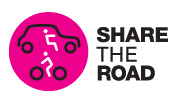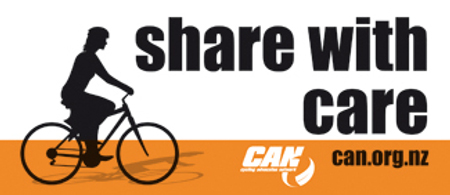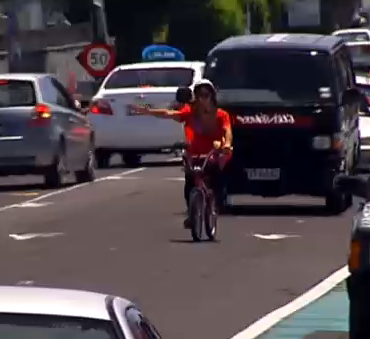
Share the Road
Report on campaigns already in existence both NZ & international
1. What works?
Bicycle Safety Campaign Review
What do successful bicycle safety campaigns have in common, and what tactics should be used in the future to achieve success? To help answer this, Bikes Belong (USA) conducted a review of campaigns, primarily used in the U.S.
In the U.S., most bicycle safety campaigns focus on informing road users rather than on convincing behavior change. It's easier and cheaper to provide information (laws, suggested behavior, etc) than to develop a campaign that captures peoples' emotions. But, comprehensive studies of road safety campaigns conclude that emotional campaigns are more effective at increasing safety than
informational campaigns.
Important conclusions include:
- emotional campaigns are more effective at increasing safety than informational campaigns
- safety campaigns that personalize and humanize cyclists without creating fear are ideal
- messages should be targeted at wide audiences that include both motorists and cyclists
- indirectly encourage more people to cycle; there's safety in numbers
- explain cyclist behavior
- get into the system
Active Transport Resources report
See the Active Transport Resources report attached below as a pdf. This was prepared by Y&R in 2009 for NZTA.
Purpose
NZTA has a suite of Share the Road resources for territorial authorities to use , and STR initiatives have been running in New Zealand for the past 8-9 years. Increasingly, however, Territorial Authorities are developing their own safety messages, and many are starting to initiate active transport promotions.
As part of a review of the STR messages, the NZTA have commissioned a stock-take and analysis of existing international national, regional, and local campaigns for :
• active transport safety
• active transport promotion
This review forms the first two stages of a four part programme, culminating in a recommendation on a set of key messages and approaches that promote both safety behaviour
and encourage uptake of active transport.
This audit was not intended to be exhaustive of all campaigns worldwide. Rather it was to inform on initiatives that are better, broader, narrower, more or less effective, or creative than the current STR approach.
Where initiatives are well known, and operating in New Zealand as well as overseas (such as Walking School Bus programmes) they have not been detailed.
The audit was also not intended to include specific Share the Road campaigns, as the NZTA already has high awareness of these.
2. NZ campaigns
Share the Road campaign guidance
NZTA, 2006
This publication contains a list of existing share the road resources and projects and outlines new ideas to promote good practice share the road projects. It is envisaged that this resource will be a reference document to help practitioners motivate and encourage community groups and project teams to plan good practice promotional projects to address issues identified for action in their communities.
http://www.nzta.govt.nz/resources/share-the-road-campaign/
HTML: http://www.nzta.govt.nz/resources/share-the-road-campaign/share-the-road...
PDF: http://www.nzta.govt.nz/resources/share-the-road-campaign/docs/share-the...
Includes Share the road project examples:
Speed campaign | Tauranga City Council and Western Bay of Plenty District Council
Speed campaign | Auckland Region
Speed stopping distance events | Christchurch
Teenage pedestrians | United Kingdom
Turning traffic give way to pedestrians | Christchurch
Sunny gets smart road safety drama | Nelson
Mobility scooter workshops | Ashburton, Waimakariri
Helping hands: a guide for parents and caregivers | NZ Police
Red and green people pedestrian project | Wellington Region
Driveway resource | Waitakere
Driveway display | Christchurch
Cycle Safe | Christchurch
Be safe be seen | Tauranga
Don't burst their bubble | Waimakariri
Share the road | Tauranga City and Western Bay of Plenty
Stop. Look. Cyclist. | Christchurch
Share the road | Christchurch
Share the road | Victoria
Share the road | Queensland
Cycle lanes campaign | Christchurch
Wellington
http://www.gw.govt.nz/mind-the-gap/
Following on from the 'Don't Burst their Bubble' and 'Share the Road' courtesy campaigns, Greater Wellington launched a 'Mind the Gap' campaign in June 2010. This promotes safe overtaking distances, primarily between bikes and cars, but also between pedestrians and cars, and pedestrians and bikes.
Wellington Waterfront
Cruise the waterfront
Wellington cyclists are cleaning up their act with a courtesy campaign aimed at curbing bad biking behaviour on the waterfront.
Waterfront courtesy code
Pedestrians:
Cruise with an ear out for other cruisers (one earphone out or low volume)
Keep kids and pets in close proximity
Bikers:
Cruise at a leisurely pace
Give pedestrians a wide berth
Make yourself heard (a friendly bell or call out)
Be well lit at night
CAN
stickers
Southland
Welcome to the site of the Share the Road campaign which runs in Southland as part of the Powernet Tour of Southland.
"Share the Road", incorporating the Powernet Tour of Southland, is a campaign funded by Road Safety Southland and delivered by Sport Southland.The unique nature of the campaign is using a professional cycle race, and the riders, to promote the road safety message. The main aim is to promote the Share the Road messages of road safety while getting more people active through safe cycling.
http://www.sportsouthland.co.nz/sharetheroad_new
Email: brendon.mcdermott@sportsouthland.co.nz
New Plymouth
http://www.sharetheroad.co.nz/
Share the Road is a campaign, started in London in 2008, that speaks to all road users as people. We advocate simply that we all respect each other's equal right to use the road.
Contact: benefieldn@npdc.govt.nz
Roadsafe Auckland
http://www.roadsafeauckland.org.nz/campaigns/index.cfm?id=1035
Franklin
Mind the Gap
http://www.franklinmtb.org.nz/news_letter.htm
Selwyn, Canterbury
http://www.selwyn.govt.nz/services/roading/road-safety/share-the-road
Old Tai Tapu Road is a well cycled route for many cyclists, as part of the ‘Share the Road' promotion we have installed a ‘Share the Road' billboard on Old Tai Tapu Road for three months. It's a reminder for both cyclists and cars to practice mutual respect towards each other.
News media
TV3's Campbell does Share the Road, including this advice

Taking the lane
Look, signal, move
courtesy
1.5 million people ride bikes in NZ
advice for group riding (use less busy routes, less busy times)
and more.
The driving instructor's advice was also pretty sound:
scan for people on bikes
anticipate that the rider may need to take the lane at pinch points
hang back a few seconds
3. NZ Research
Literature review
Alliston, L. and Cossar, D. (2004). Walking and Cycling: Education and Promotion Initiatives to Improve Road Safety: a Literature Review. Report prepared for the Land Transport Safety Authority, Wellington, NZ.
This review outlines the information available on education and promotional initiatives that aim to improve road safety for pedestrians and cyclists. The focus of this review is on educational programmes.
Author(s): Lousie Alliston and Debbie Cossar
Publisher(s): Land Transport Safety Authority
Reference #: BRC # 2953
PDF: http://www.livingstreets.org.nz/node/wrduploads/Walking%20and%20cycling%...
LTNZ, 2005: Research Report 273 Balancing the needs of cyclists and motorists
http://www.nzta.govt.nz/resources/research/reports/273/
Between 2002-2004 a four-part research programme was undertaken to identify hazards to cyclists from features of the road network that are designed to benefit motorists. The four studies were:
1: the effects of roadside obstacles on cycle stability
2: the effects of trucks passing on cycle stability
3: the effects of roadside obstacles on cyclists' behaviour
4: parents' perceptions of cycle safety for high-school children.
The perspective of the research is to recognise and understand the conflicting needs of cyclists and motorists who share a road corridor. The outcome is to facilitate more informed decision-making in design, maintenance and management of the road corridor by balancing the needs of cyclists and motorists.
4. International campaigns
UK: Share the Road|
http://www.sharetheroad.org.uk/
Share the Road aims to get us thinking about road users as people, and thus help turn the roads into a level playing field. It is explicity not anti-car, yet the more of us who walk and cycle, the safer it gets, which may encourage more motorists to give it a try.
International campaigns
http://www.sharetheroad.org.uk/international.html
Share the Road initiatives are most popular in countries where, like the UK, walking and cycling have a low modal share. The citizens of continental Europe appear to share the road without having to be asked.
The Australian government's imaginative use of TV commercials (It takes two to tango) rewards considerate road behaviour with respect and status.
Queensland Transport: http://www.tmr.qld.gov.au/~/media/a89e0710-2cf2-4cfb-8d58-5b98e532bd5a/p...
UK: Do the Test
http://youtu.be/Ahg6qcgoay4
How many passes does the team in white make? Test your awareness and Do the Test! TFL cycling safety advert! Count the number of passes the White team makes.
USA, Marin, California
http://www.marinbike.org/Campaigns/ShareTheRoad/Index.shtml
The Share the Road campaign is educating bicyclists and motorists to share the road courteously and safely.
Co-exist
The Coexist Campaign is a citywide effort to encourage greater respect between bicyclists and motorists, hopefully resulting in safer roads for all users.
Why Is This An Issue?
With more traffic congestion on city streets and more people turning to bicycling as a transportation alternative, we need to make sure all road users understand safe and proper road behavior -- particularly how motorists and bicyclists should legally and safely share the road.
How Do You Expect A Campaign Like This To Change People's Behavior?
We expect to start a dialogue between motorists and bicyclists about their interactions on the streets. Too often, we stereotype a group of road users based just on one or two isolated experiences. This campaign will remind us that the vast majority of people -- whether driving or riding bikes -- want to do the right thing, to share the road, and to just get along. By starting a public dialogue about co-existing on the streets, we hope more people will show a little more patience and a little more civility on the road.
| Attachment | Size |
|---|---|
| 210.74 KB |
